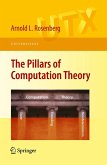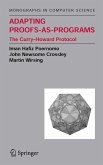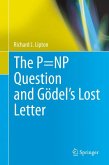Steven G. Krantz
Handbook of Logic and Proof Techniques for Computer Science (eBook, PDF)
40,95 €
40,95 €
inkl. MwSt.
Sofort per Download lieferbar

20 °P sammeln
40,95 €
Als Download kaufen

40,95 €
inkl. MwSt.
Sofort per Download lieferbar

20 °P sammeln
Jetzt verschenken
Alle Infos zum eBook verschenken
40,95 €
inkl. MwSt.
Sofort per Download lieferbar
Alle Infos zum eBook verschenken

20 °P sammeln
Steven G. Krantz
Handbook of Logic and Proof Techniques for Computer Science (eBook, PDF)
- Format: PDF
- Merkliste
- Auf die Merkliste
- Bewerten Bewerten
- Teilen
- Produkt teilen
- Produkterinnerung
- Produkterinnerung

Bitte loggen Sie sich zunächst in Ihr Kundenkonto ein oder registrieren Sie sich bei
bücher.de, um das eBook-Abo tolino select nutzen zu können.
Hier können Sie sich einloggen
Hier können Sie sich einloggen
Sie sind bereits eingeloggt. Klicken Sie auf 2. tolino select Abo, um fortzufahren.

Bitte loggen Sie sich zunächst in Ihr Kundenkonto ein oder registrieren Sie sich bei bücher.de, um das eBook-Abo tolino select nutzen zu können.
A concise and essential resource for basic logic concepts, methods and information. The book is an excellent resource for the working mathematical scientist. Graduate students, practitioners and professionals in computer science and engineering, or the systems scientist who needs a quick sketch of a key idea from logic, will find it in this self-contained, accessible, and easy-to-use reference.
- Geräte: PC
- ohne Kopierschutz
- eBook Hilfe
- Größe: 18.03MB
Andere Kunden interessierten sich auch für
![The Pillars of Computation Theory (eBook, PDF) The Pillars of Computation Theory (eBook, PDF)]() Arnold L. RosenbergThe Pillars of Computation Theory (eBook, PDF)40,95 €
Arnold L. RosenbergThe Pillars of Computation Theory (eBook, PDF)40,95 €![New Computational Paradigms (eBook, PDF) New Computational Paradigms (eBook, PDF)]() New Computational Paradigms (eBook, PDF)112,95 €
New Computational Paradigms (eBook, PDF)112,95 €![Adapting Proofs-as-Programs (eBook, PDF) Adapting Proofs-as-Programs (eBook, PDF)]() Iman PoernomoAdapting Proofs-as-Programs (eBook, PDF)112,95 €
Iman PoernomoAdapting Proofs-as-Programs (eBook, PDF)112,95 €![Logic Functions and Equations (eBook, PDF) Logic Functions and Equations (eBook, PDF)]() Christian PosthoffLogic Functions and Equations (eBook, PDF)128,95 €
Christian PosthoffLogic Functions and Equations (eBook, PDF)128,95 €![The P=NP Question and Gödel's Lost Letter (eBook, PDF) The P=NP Question and Gödel's Lost Letter (eBook, PDF)]() Richard J. LiptonThe P=NP Question and Gödel's Lost Letter (eBook, PDF)72,95 €
Richard J. LiptonThe P=NP Question and Gödel's Lost Letter (eBook, PDF)72,95 €![A Proof Theory for Description Logics (eBook, PDF) A Proof Theory for Description Logics (eBook, PDF)]() Alexandre RademakerA Proof Theory for Description Logics (eBook, PDF)40,95 €
Alexandre RademakerA Proof Theory for Description Logics (eBook, PDF)40,95 €![Logic and Its Applications (eBook, PDF) Logic and Its Applications (eBook, PDF)]() Logic and Its Applications (eBook, PDF)52,95 €
Logic and Its Applications (eBook, PDF)52,95 €-
-
-
A concise and essential resource for basic logic concepts, methods and information. The book is an excellent resource for the working mathematical scientist. Graduate students, practitioners and professionals in computer science and engineering, or the systems scientist who needs a quick sketch of a key idea from logic, will find it in this self-contained, accessible, and easy-to-use reference.
Dieser Download kann aus rechtlichen Gründen nur mit Rechnungsadresse in A, B, BG, CY, CZ, D, DK, EW, E, FIN, F, GR, HR, H, IRL, I, LT, L, LR, M, NL, PL, P, R, S, SLO, SK ausgeliefert werden.
Produktdetails
- Produktdetails
- Verlag: Birkhäuser Boston
- Seitenzahl: 245
- Erscheinungstermin: 6. Dezember 2012
- Englisch
- ISBN-13: 9781461201151
- Artikelnr.: 44199375
- Verlag: Birkhäuser Boston
- Seitenzahl: 245
- Erscheinungstermin: 6. Dezember 2012
- Englisch
- ISBN-13: 9781461201151
- Artikelnr.: 44199375
- Herstellerkennzeichnung Die Herstellerinformationen sind derzeit nicht verfügbar.
1 Notation and First-Order Logic.- 1.1 The Use of Connectives.- 1.2 Truth Values and Truth Tables.- 1.3 The Use of Quantifiers.- 1.4 Gödel's Completeness Theorem.- 1.5 Second-Order Logic.- 2 Semantics and Syntax.- 2.1 Elementary Symbols.- 2.2 Well-Formed Formulas or wffs [Syntax].- 2.3 Free and Bound Variables (Syntax).- 2.4 The Semantics of First-Order Logic.- 3 Axiomatics and Formalism in Mathematics.- 3.1 Basic Elements.- 3.2 Models.- 3.3 Consistency.- 3.4 Gödel's Incompleteness Theorem.- 3.5 Decidability and Undecidability.- 3.6 Independence.- 4 The Axioms of Set Theory.- 4.1 Introduction.- 4.2 Axioms and Discussion.- 4.3 Concluding Remarks.- 5 Elementary Set Theory.- 5.1 Set Notation.- 5.2 Sets, Subsets, and Elements.- 5.3 Binary Operations on Sets.- 5.4 Relations and Equivalence Relation.- 5.5 Equivalence Relations.- 5.6 Number Systems.- 5.7 Functions.- 5.8 Cardinal Numbers.- 5.9 A Word About Classes.- 5.10 Fuzzy Set Theory.- 5.11 The Lambda Calculus.- 5.12 Sequences.- 5.13 Bags.- 6 Recursive Functions.- 6.1 Introductory Remarks.- 6.2 Primitive Recursive Functions.- 6.3 General Recursive Functions.- 7 The Number Systems.- 7.1 The Natural Numbers.- 7.2 The Integers.- 7.3 The Rational Numbers.- 7.4 The Real Numbers.- 7.5 The Complex Numbers.- 7.6 The Quaternions.- 7.7 The Cayley Numbers.- 7.8 Nonstandard Analysis.- 8 Methods of Mathematical Proof.- 8.1 Axiomatics.- 8.2 Proof by Induction.- 8.3 Proof by Contradiction.- 8.4 Direct Proof.- 8.5 Other Methods of Proof.- 9 The Axiom of Choice.- 9.1 Enunciation of the Axiom.- 9.2 Examples of the Use of the Axiom of Choice.- 9.3 Consequences of the Axiom of Choice.- 9.4 Paradoxes.- 9.5 The Countable Axiom of Choice.- 9.6 Consistency of the Axiom of Choice.- 9.7 Independence of the Axiom of Choice.- 10 Proof Theory.-10.1 General Remarks.- 10.2 Cut Elimination.- 10.3 Propositional Resolution.- 10.4 Interpolation.- 10.5 Finite Type.- 10.6 Beth's Definability Theorem.- 11 Category Theory.- 11.1 Introductory Remarks.- 11.2 Metacategories and Categories.- 12 Complexity Theory.- 12.1 Preliminary Remarks.- 12.2 Polynomial Complexity.- 12.3 Exponential Complexity.- 12.4 Two Tables for Complexity Theory.- 12.5 Problems of Class P.- 12.6 Problems of Class NP.- 12.7 NP-Completeness.- 12.8 Cook's Theorem.- 12.9 Examples of NP-Complete Problems.- 12.10 More on P/NP.- 12.11 Descriptive Complexity Theory.- 13 Boolean Algebra.- 13.1 Description of Boolean Algebra.- 13.2 Axioms of Boolean Algebra.- 13.3 Theorems in Boolean Algebra.- 13.4 Illustration of the Use of Boolean Logic.- 14 The Word Problem.- 14.1 Introductory Remarks.- 14.2 What Is a Group?.- 14.3 What Is a Free Group?.- 14.4 The Word Problem.- 14.5 Relations and Generators.- 14.6 Amalgams.- 14.7 Description of the Word Problem.- List of Notation from Logic.- Glossary of Terms from Mathematical and Sentential Logic.- A Guide to the Literature.
1 Notation and First-Order Logic.- 1.1 The Use of Connectives.- 1.2 Truth Values and Truth Tables.- 1.3 The Use of Quantifiers.- 1.4 Gödel's Completeness Theorem.- 1.5 Second-Order Logic.- 2 Semantics and Syntax.- 2.1 Elementary Symbols.- 2.2 Well-Formed Formulas or wffs [Syntax].- 2.3 Free and Bound Variables (Syntax).- 2.4 The Semantics of First-Order Logic.- 3 Axiomatics and Formalism in Mathematics.- 3.1 Basic Elements.- 3.2 Models.- 3.3 Consistency.- 3.4 Gödel's Incompleteness Theorem.- 3.5 Decidability and Undecidability.- 3.6 Independence.- 4 The Axioms of Set Theory.- 4.1 Introduction.- 4.2 Axioms and Discussion.- 4.3 Concluding Remarks.- 5 Elementary Set Theory.- 5.1 Set Notation.- 5.2 Sets, Subsets, and Elements.- 5.3 Binary Operations on Sets.- 5.4 Relations and Equivalence Relation.- 5.5 Equivalence Relations.- 5.6 Number Systems.- 5.7 Functions.- 5.8 Cardinal Numbers.- 5.9 A Word About Classes.- 5.10 Fuzzy Set Theory.- 5.11 The Lambda Calculus.- 5.12 Sequences.- 5.13 Bags.- 6 Recursive Functions.- 6.1 Introductory Remarks.- 6.2 Primitive Recursive Functions.- 6.3 General Recursive Functions.- 7 The Number Systems.- 7.1 The Natural Numbers.- 7.2 The Integers.- 7.3 The Rational Numbers.- 7.4 The Real Numbers.- 7.5 The Complex Numbers.- 7.6 The Quaternions.- 7.7 The Cayley Numbers.- 7.8 Nonstandard Analysis.- 8 Methods of Mathematical Proof.- 8.1 Axiomatics.- 8.2 Proof by Induction.- 8.3 Proof by Contradiction.- 8.4 Direct Proof.- 8.5 Other Methods of Proof.- 9 The Axiom of Choice.- 9.1 Enunciation of the Axiom.- 9.2 Examples of the Use of the Axiom of Choice.- 9.3 Consequences of the Axiom of Choice.- 9.4 Paradoxes.- 9.5 The Countable Axiom of Choice.- 9.6 Consistency of the Axiom of Choice.- 9.7 Independence of the Axiom of Choice.- 10 Proof Theory.-10.1 General Remarks.- 10.2 Cut Elimination.- 10.3 Propositional Resolution.- 10.4 Interpolation.- 10.5 Finite Type.- 10.6 Beth's Definability Theorem.- 11 Category Theory.- 11.1 Introductory Remarks.- 11.2 Metacategories and Categories.- 12 Complexity Theory.- 12.1 Preliminary Remarks.- 12.2 Polynomial Complexity.- 12.3 Exponential Complexity.- 12.4 Two Tables for Complexity Theory.- 12.5 Problems of Class P.- 12.6 Problems of Class NP.- 12.7 NP-Completeness.- 12.8 Cook's Theorem.- 12.9 Examples of NP-Complete Problems.- 12.10 More on P/NP.- 12.11 Descriptive Complexity Theory.- 13 Boolean Algebra.- 13.1 Description of Boolean Algebra.- 13.2 Axioms of Boolean Algebra.- 13.3 Theorems in Boolean Algebra.- 13.4 Illustration of the Use of Boolean Logic.- 14 The Word Problem.- 14.1 Introductory Remarks.- 14.2 What Is a Group?.- 14.3 What Is a Free Group?.- 14.4 The Word Problem.- 14.5 Relations and Generators.- 14.6 Amalgams.- 14.7 Description of the Word Problem.- List of Notation from Logic.- Glossary of Terms from Mathematical and Sentential Logic.- A Guide to the Literature.







